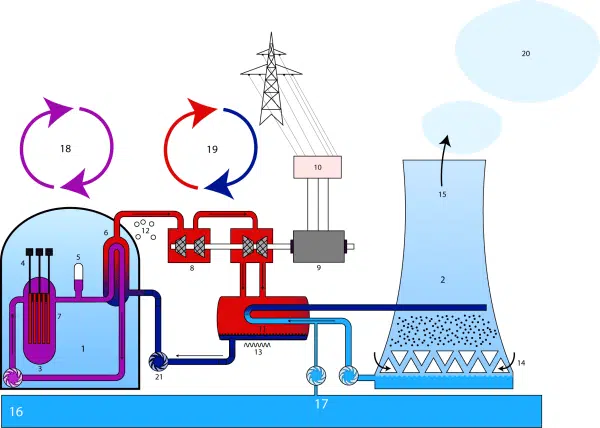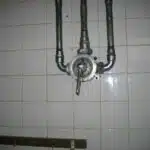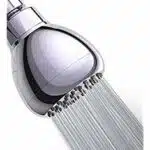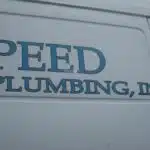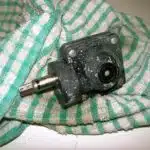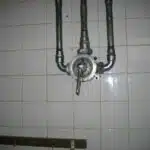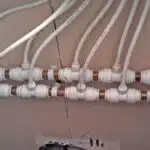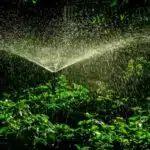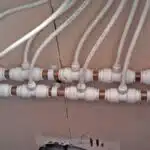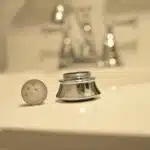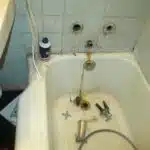As a plumbing expert, it is not uncommon to receive complaints from homeowners about super-high water pressure. While it may seem like a luxury to have strong water pressure in your home, it can actually cause damage to your pipes and appliances if left unchecked. Additionally, high water pressure can lead to wasting more water than necessary and higher utility bills.
In this article, we will explore the common causes of super-high water pressure and provide practical solutions on how to fix it. We understand that having functional plumbing is crucial for daily living and serving others, which is why we strive to provide easy-to-follow steps that anyone can implement in their home. So whether you’re experiencing sporadic bursts of high-pressure water or consistently high levels, read on to learn how you can restore your plumbing system to optimal function while also conserving resources.
Understanding Water Pressure
Water pressure regulation is a crucial aspect of plumbing that affects the efficiency and longevity of pipes, fixtures, and appliances. Ideally, water pressure should fall within the range of 40 to 80 pounds per square inch (psi). Anything above this range is considered high water pressure, which can lead to several issues such as leaks, burst pipes, and premature wear and tear on plumbing components. On the other hand, low water pressure can cause inconvenience in daily activities like showering or washing dishes.
To determine water pressure levels, plumbing experts use specialized tools like pressure gauges or manometers. These devices measure the amount of force that water exerts on pipes when flowing through them. If you suspect that your home has high water pressure, it’s advisable to hire a professional plumber to perform an accurate measurement using these techniques.
Water pressure measurement techniques are essential for identifying potential problems with your plumbing system before they escalate into major issues. By understanding how to measure and regulate water pressure in your home or business, you can prevent costly repairs and ensure comfortable living conditions for everyone using the facilities. In the following section, we will discuss some signs that indicate your home may have high water pressure and what steps you can take to fix it.
Signs Of High Water Pressure
Understanding the water pressure in your home is crucial to maintaining a healthy plumbing system. In the previous section, we explored how water pressure works and what factors can affect it. Now, let’s dive deeper into the signs that indicate high water pressure and ways to prevent it from damaging your pipes.
Signs of high water pressure can be subtle at first, but they can quickly turn into significant problems if left unaddressed. Some common indicators include banging or rattling pipes, leaky faucets, and constantly running toilets. You may also notice that your washing machine or dishwasher is filling up slower than usual. If these issues persist, it’s essential to call a licensed plumber to inspect your system before any further damage occurs.
Preventing high water pressure is much easier than fixing it after the fact. Here are three ways you can ensure that your plumbing system stays healthy:
Install a pressure regulator: A pressure regulator will help keep the water pressure at a safe level by reducing excess pressure before it enters your home.
Check for leaks: Even small leaks can cause significant increases in water pressure over time. Regularly inspecting your plumbing system for leaks can help prevent high water pressure and save you money on water bills.
Schedule regular maintenance: Having a licensed plumber perform routine maintenance on your plumbing system can help catch potential issues before they become major problems.
By understanding the signs of high water pressure and taking preventative measures, you can avoid costly repairs and keep your plumbing system running smoothly for years to come. In the next section, we’ll explore the common causes of high water pressure and how to fix them effectively.
Common Causes Of High Water Pressure
A common problem with residential plumbing systems is high water pressure. This can lead to a host of issues, such as leaks, pipe bursts, and damaged appliances. The most common cause of high water pressure is a malfunctioning pressure regulator.
Pressure regulators are responsible for maintaining a safe and consistent flow of water in your home’s plumbing system. When they fail, the result can be dangerously high water pressure that puts stress on pipes and other components of your plumbing system. To determine if your pressure regulator is malfunctioning, you’ll need to test your home’s water pressure using a gauge. If the reading is consistently above 80 psi, it’s likely that your regulator needs to be replaced.
Another factor that can contribute to high water pressure is the layout of your plumbing system. In some cases, certain fixtures or appliances may be located too far from the main supply line, resulting in increased water pressure at those points in the system. Additionally, poorly designed or outdated plumbing systems may not have sufficient safeguards in place to regulate water flow and prevent excessive pressure buildup.
It’s important to address high water pressure as soon as possible to avoid potential damage to your plumbing system and costly repairs down the line. By identifying the root cause of the issue – whether it’s a malfunctioning pressure regulator or an underlying problem with your plumbing system layout – you can take steps to restore safe and consistent water flow throughout your home.
Moving forward, it’s crucial to understand the dangers associated with high water pressure in order to properly mitigate them. In order to prevent further damage and maintain a healthy plumbing system for years to come, homeowners should educate themselves on how best to address this common issue and take action accordingly.
The Dangers Of High Water Pressure
Regulating water pressure is a crucial aspect of plumbing maintenance. High water pressure can cause significant damage to plumbing fixtures, leading to leaks and bursts that can be expensive to repair. It is essential to ensure that the water pressure in your home or business remains within acceptable limits to avoid these problems.
The effects of high water pressure on plumbing fixtures are numerous. Excess pressure can cause pipes to burst or crack, leading to costly repairs and potential property damage. Additionally, high water pressure can wear down faucets and other plumbing fixtures, resulting in leaks that waste water and increase your utility bills. Over time, the cumulative effect of high water pressure can cause significant damage to your entire plumbing system.
To avoid the dangers associated with high water pressure, it is critical to regulate the pressure in your home or business. Here are three reasons why you should take this issue seriously:
High water pressure puts unnecessary stress on your plumbing fixtures, leading to costly repairs and replacements.
Leaks caused by high water pressure waste valuable resources and drive up your utility bills.
Over time, unchecked high-water pressure can lead to significant damage to your entire plumbing system, requiring extensive repairs.
In summary, regulating your home or business’s water pressure is critical for maintaining healthy plumbing fixtures and avoiding costly repairs down the line. Understanding the effects of high-pressure situations on your pipes and fittings is crucial for taking appropriate measures in preventing such issues from happening in the future. In the next section, we’ll explore some essential tools needed for fixing high-water pressure without causing further damages in the process.
Tools Needed For Fixing High Water Pressure
Back in the day, fixing high water pressure issues required some basic tools such as pipe wrenches and pressure gauges. These tools are still essential today, and every plumbing expert knows that they form the foundation of any successful repair job. Pipe wrenches are used to tighten or loosen fittings, while pressure gauges help measure the water pressure in your pipes.
Before you start fixing high water pressure issues, it is important to have these tools ready at hand. Check that your pipe wrenches are adjustable and can fit a wide range of diameters. Ensure that your pressure gauge has a clear display and can read both static and dynamic pressures accurately.
Having these tools is only half the battle won; you also need to know how to use them effectively. A professional plumbing expert understands how important it is to be well-versed in the various techniques for using these tools. With proper knowledge on how to use pipe wrenches and pressure gauges, you can easily diagnose and fix high water pressure issues with ease.
Now that we have looked at the importance of having pipe wrenches and pressure gauges for fixing high water pressure issues, our next section will delve into a step-by-step guide on how to fix this problem. Armed with the right tools and knowledge, you will soon be able to resolve any high water pressure problems like a pro!
Step-By-Step Guide To Fixing Water Pressure
Identifying water pressure problems can be done by monitoring the water flow and noticing any changes in pressure or water pressure fluctuations. Testing water pressure levels can be done with a water pressure gauge to measure the water pressure in the home’s plumbing system. Adjusting water pressure regulators involves turning the adjustment screw to reduce the water pressure to the desired level. Replacing faulty valves, worn out pipes, or other parts of the plumbing system may be necessary if there is an issue with the pressure that cannot be fixed by adjusting the regulator.
Identifying Water Pressure Problems
Water pressure management is a crucial aspect of maintaining the functionality of your home’s plumbing system. However, sometimes water pressure can become too high and cause damage to your pipes, appliances, and fixtures. Identifying water pressure problems is the first step in fixing this issue.
One way to identify high water pressure is by checking your fixtures for signs of damage or leaks. High pressure can cause faucets to leak or even burst, leading to costly repairs. Additionally, if you notice that your toilet tank keeps refilling even when it’s not in use or that your washing machine is shaking excessively during use, these could also be signs of high water pressure.
If you have identified high water pressure as the problem, there are several DIY solutions you can try before calling a professional plumber. One option is installing a pressure regulator on your main water line. This device will help regulate the flow and keep the water pressure at safe levels. However, if you’re not comfortable with DIY installation, it’s best to leave it to the professionals to ensure proper installation and avoid any further issues down the line.
Testing Water Pressure Levels
Maintaining a consistent and safe water pressure level is essential for ensuring the proper functioning of your plumbing system. As a plumbing expert, it is important to know how to diagnose and fix any issues related to water pressure. In addition to identifying high water pressure, it’s also crucial to measure the accuracy of the pressure levels regularly.
Testing water pressure levels requires selecting the appropriate equipment for accurate readings. The most common equipment used for this task is a pressure gauge. This device can be attached to an outdoor faucet or hose bibb, allowing you to measure the incoming water pressure from your main supply line. It’s important to note that gauges can vary in accuracy, so it’s best to choose a high-quality gauge with a range that matches your home’s expected pressure levels.
To test your water pressure accurately, attach the gauge to an outdoor faucet or hose bibb and turn on the water fully. The gauge will display the current water pressure reading in pounds per square inch (PSI). Repeat this process at various times throughout the day and on different days of the week to ensure consistent results. If your readings consistently show high water pressure levels above 80 PSI, it’s important to take action and install a pressure regulator or seek professional assistance before any damage occurs.
By regularly testing your home’s water pressure levels using accurate equipment selection, you can catch issues early and prevent costly repairs down the line. As a plumbing expert, I recommend homeowners make testing their water pressure part of their regular maintenance routine and take necessary actions promptly if they identify any concerns with high or low-pressure levels.
Adjusting The Pressure Regulator
Now that we have gone through the step-by-step process of fixing water pressure, it is important to note that adjusting the pressure regulator is one of the best practices for ensuring optimal water pressure. Pressure regulators are installed in homes to regulate the water pressure and ensure that it stays within a safe range. These regulators can be adjusted to increase or decrease the pressure, depending on your needs.
To adjust your pressure regulator, start by locating it near the main shutoff valve or where the main water line enters your home. Use a wrench to loosen the locking nut and turn the adjustment screw clockwise to increase pressure or counterclockwise to decrease it. It is important not to over-tighten or force any adjustments as this can damage the regulator.
If you have adjusted your regulator and still experience high water pressure issues, there may be underlying problems that require troubleshooting. Check for leaks in your pipes or faucets, as these can cause high water pressure. It is also recommended to check your expansion tank and make sure it is functioning properly. If all else fails, you may need to replace a faulty pressure regulator.
Transition: While adjusting your pressure regulator is a great way to troubleshoot high water pressure issues, sometimes you may need to replace a faulty one altogether.
Replacing Faulty Pressure Regulators
Are you experiencing super-high water pressure? One possible culprit could be a faulty pressure regulator. Pressure regulators are responsible for maintaining a safe and consistent water pressure throughout your home’s plumbing system. When they malfunction, they can cause water pressure to skyrocket, which can lead to issues such as burst pipes and damaged appliances. Fortunately, replacing a faulty pressure regulator is a relatively straightforward process that can help alleviate this problem.
Before replacing the pressure regulator, it’s important to test the water pressure in your home. This will give you an idea of how high the pressure is and whether it is indeed the cause of your issues. You can purchase a pressure gauge at most hardware stores or online retailers. Simply attach the gauge to an outdoor spigot and turn on the water. A safe range for residential water pressure is typically between 40-80 psi (pounds per square inch). If your gauge reads above this range, then it may be time to replace your pressure regulator.
While replacing a faulty pressure regulator may seem like a daunting task, there are DIY solutions available that can help save you money on hiring a professional plumber. It’s important to note that if you’re not comfortable working with plumbing systems or lack experience in this area, it may be best to leave this task to the experts. However, if you’re up for the challenge, there are plenty of instructional videos and guides available online that can walk you through the process step-by-step. By taking matters into your own hands, you’ll not only save money but gain valuable knowledge about how your home’s plumbing system works.
Ready to tackle more plumbing problems? The next section will cover fixing leaks and broken pipes – another common issue homeowners face when it comes to their plumbing systems. By addressing these issues promptly and efficiently, you can prevent further damage from occurring and keep your home’s plumbing system running smoothly for years to come.
Fixing Leaks And Broken Pipes
After replacing the faulty pressure regulator, it’s important to check for any leaks or broken pipes that could contribute to super-high water pressure. These issues are common causes of high water pressure and can lead to significant damage if left unchecked.
One sign of a leak is a sudden increase in your water bill or wet spots on walls or ceilings. Another indicator is the sound of running water when no faucets are turned on. Broken pipes can also cause low water pressure in addition to high pressure, as water may be escaping before it reaches your fixtures.
If you notice any signs of leaks or broken pipes, it’s important to address them immediately. Ignoring these issues can lead to more costly repairs down the line, including damage to your home’s structure. In the next section, we’ll discuss how to repair faulty valves that may be contributing to high water pressure.
Repairing Faulty Valves
To fix super-high water pressure, one must first check the valves. Faulty valves are a common cause of high water pressure. Check to ensure that all the valves are fully open and not leaking. If the valve is damaged or is not working correctly, it needs to be replaced.
Replacing pipes may also be necessary if the water pressure is too high. Sometimes old pipes can cause water pressure issues due to corrosion or blockage. The type of pipes used in your plumbing system affects the overall performance of your water supply. Consider replacing old pipes with new ones made of durable materials like copper or PVC.
Another option for controlling high water pressure is installing a pressure control device. A pressure control device regulates the flow rate of water into your home, which helps prevent damage to appliances and fixtures caused by excessive water pressure. It also improves energy efficiency by reducing the amount of wasted water.
Transition: Once you have repaired faulty valves, replaced old pipes, or installed a pressure control device, it’s important to flush the system to ensure everything works efficiently and effectively.
Flushing The System
Have you ever seen a clogged drain? It’s like trying to force water through a straw that’s been pinched in half. This is what high water pressure can feel like in your pipes. Flushing the system can help reduce this pressure and keep your plumbing working smoothly.
Flushing techniques are essential for maintaining healthy pipes. Start by turning off all of the fixtures in your home and opening the main valve that leads into your house. Allow the water to run for several minutes until it runs clear. This will help flush out any sediment or debris that may have accumulated in your pipes, which can contribute to increased pressure.
Water flow analysis is another effective way to identify potential issues with high water pressure. A professional plumber can perform a series of tests on your system to determine where the problem areas are and develop an effective solution. By analyzing water flow rates, they can pinpoint where the blockages or restrictions are occurring, and recommend flushing techniques and other remedies to restore proper water flow throughout your plumbing system.
By flushing your system regularly and performing regular water flow analysis, you can prevent high water pressure from causing damage to your pipes and appliances. The next step is installing pressure reducing valves, which we’ll cover in the next section.
Installing Pressure Reducing Valves
After flushing the system, it’s time to address the root cause of super-high water pressure by installing pressure reducing valves. These valves regulate water pressure and prevent damage to pipes and appliances caused by excessive force. Choosing appropriate valves is crucial in achieving optimal performance and maintaining safety in your plumbing system.
When selecting pressure reducing valves, consider the specific needs of your home or building. Factors such as water flow rate, pipe material, and incoming water pressure should be taken into account. It’s recommended to consult with a professional plumber for guidance on which valves are suitable for your property.
Benefits of professional installation include accurate sizing, proper placement, and adherence to local codes and regulations. A licensed plumber can ensure that the valve is installed correctly and functioning properly, providing peace of mind that your plumbing system is protected from high water pressure.
Maintaining proper water pressure is essential for the longevity of your plumbing system and the safety of those using it. The next section will cover tips for monitoring and adjusting water pressure to prevent future issues.
Maintaining Proper Water Pressure
Proper water pressure is essential for the efficient functioning of your plumbing system. High water pressure can cause damage to pipes, fixtures, and appliances, while low water pressure can lead to unsatisfactory performance and frustrating experiences. Therefore, it is crucial to ensure that you maintain the right water pressure in your home.
Importance of regular maintenance Regular maintenance is critical in maintaining proper water pressure. Over time, buildup of minerals and debris can clog pipes and restrict water flow, causing a drop in pressure. Additionally, leaks in pipes can also lower water pressure. Therefore, it is vital to have your plumbing system inspected regularly by a professional plumber who can identify any potential issues before they escalate into more significant problems.
DIY tips for maintaining proper water pressure In addition to professional inspections, there are some DIY tips you can follow to maintain proper water pressure. One useful tip is to clean faucet aerators and showerheads regularly. These components tend to accumulate mineral deposits over time that can restrict the flow of water leading to low-pressure issues. Another useful tip is to check for leaks frequently and fix them immediately if found. This will help prevent further damage and increase the lifespan of your plumbing system.
To prevent future high water pressure without writing ‘step,’ homeowners should be aware that excessive use of certain household appliances such as dishwashers and washing machines may lead to high-pressure problems. It’s important that these appliances are used appropriately and not overloaded beyond their capacity as this puts undue strain on your plumbing system leading to high-pressure issues later on. By taking care of these simple tasks consistently, homeowners will experience optimal performance from their plumbing system with fewer incidents or repairs needed over time.
Preventing Future High Water Pressure
Water pressure maintenance is crucial in preventing future high water pressure. Regularly checking and maintaining the plumbing system can help prevent the buildup of sediment, mineral deposits, and debris that can cause blockages and increase water pressure. Replacing old or damaged pipes and valves can also help ensure smooth water flow and prevent pressure buildup.
Another effective solution to prevent high water pressure is the installation of a pressure regulator. This device helps regulate water flow and maintain a constant pressure level, preventing sudden spikes in pressure that can damage pipes and appliances. A professional plumber can assess your plumbing system’s needs and install the appropriate regulator to keep your home’s water pressure at safe levels.
Preventing future high water pressure requires proactive measures such as regular maintenance and installing a pressure regulator. These solutions not only protect your plumbing system but also save you from costly repairs caused by sudden spikes in water pressure. Consulting with a plumbing professional for help in identifying potential issues with your plumbing system is always recommended to ensure optimal performance and efficiency.
Consulting A Professional For Help
Like a rushing river, high water pressure can be a force to be reckoned with. When the pressure is too high, it can cause damage to pipes, appliances, and even cause injury. Fixing super-high water pressure requires a keen eye for detail and a steady hand.
Hiring professionals for help is often the best course of action when dealing with high water pressure issues. Experienced plumbers have the knowledge and equipment necessary to diagnose the problem accurately and efficiently. They can also provide recommendations on how to prevent future issues from arising.
While there are DIY alternatives available online, it’s important to exercise caution when attempting to fix high water pressure issues on your own. Without the right tools or expertise, you could end up causing more harm than good. It’s always better to err on the side of caution and seek professional assistance whenever possible.
Remember that fixing super-high water pressure is not a task that should be taken lightly. By hiring professionals or seeking expert advice, you can ensure that your plumbing system remains in good condition for years to come. Don’t hesitate to reach out for help when you need it – your safety and comfort depend on it.
Conclusion
Water pressure is a vital aspect of our daily lives, providing us with the necessary force to carry out various household tasks. However, high water pressure can cause significant damage to your plumbing system and lead to costly repairs. In this article, we have discussed the causes and dangers of high water pressure and provided solutions for fixing it.
According to a study by the Environmental Protection Agency (EPA), more than 20% of homes in the US have water pressure exceeding 80 psi (pounds per square inch). Such high pressures can cause leaks, burst pipes, and damage to appliances such as washing machines and dishwashers. Additionally, excessively high water pressure can be dangerous for elderly people or those with weakened immune systems as it may lead to scalding injuries.
To fix super-high water pressure, you must first understand its causes. Common reasons include faulty regulators, closed valves, or an outdated plumbing system. The installation of a pressure reducing valve is one way to address high water pressure; however, it is essential also to maintain proper water pressure by regularly checking your plumbing system’s health. To prevent future occurrences of excessive water pressure, consulting a professional plumber can help ensure appropriate installations and maintenance procedures are carried out. Overall, it is important always to monitor your home’s water pressure levels to avoid any potential damages or injuries caused by excess pressures.
Image Credits
- “File:Nuclear power plant-pressurized water reactor-PWR.png” by Steffen Kuntoff (featured)

